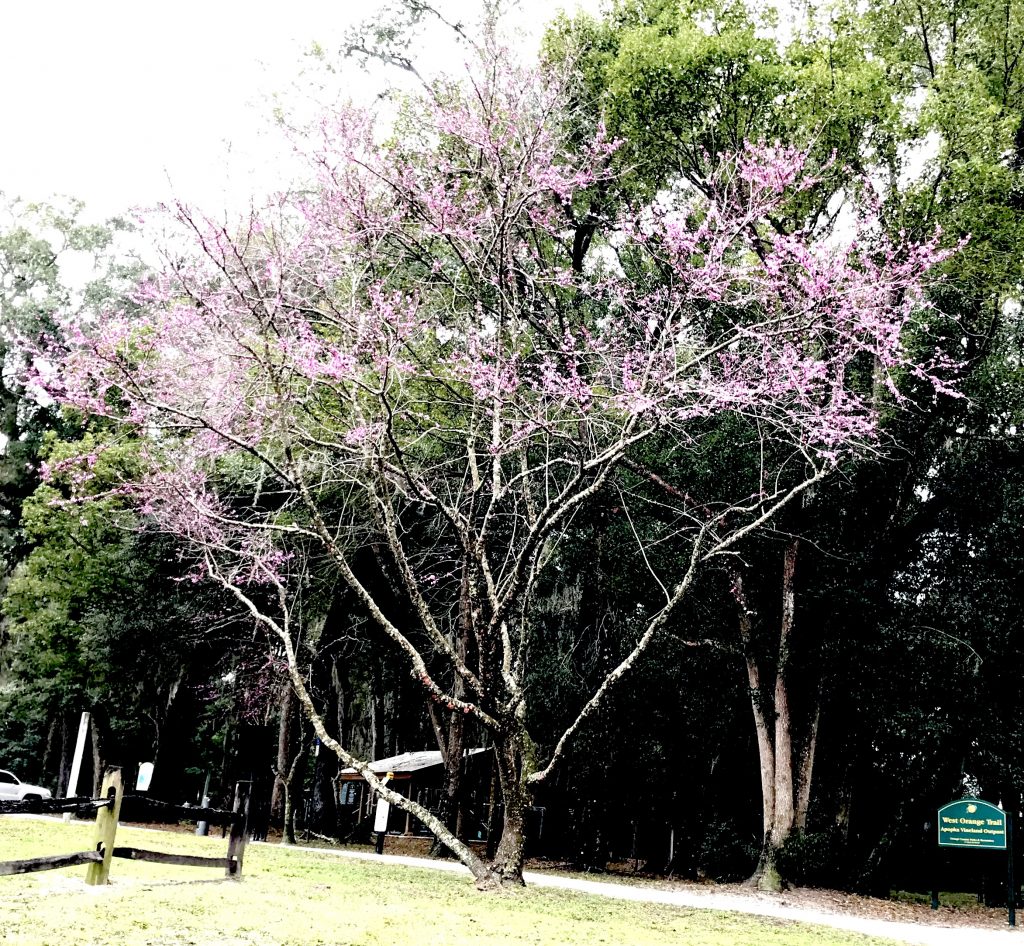
Eastern Redbud blossoming on the West Orange Bike Trail. Photo by Green Deane
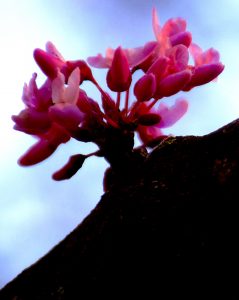
Blossoms of the Eastern Redbud. Photo by Green Deane
Most trees in the Pea Family are toxic but not all of them. One of the edible ones is blossoming now: The Eastern Redbud. The lanky tree is very easy to spot tis time of year because it has small pink blossoms and no leaves. Those small flowers — about the size of your fingernail — are important because there’s an ornamental tree with pink flowers also blossoming now that is not edible, the Pink Tabebuia. The Pink Tabebuia, however, has large blossoms about the same size as an Azalea blossom. The Eastern Redbud provides quite a few edibles: Tiny blossoms, young leaves, and pea pods. The Pink Tabebuia, T. heterophylla, does not have edible parts nor does two of its relatives, the Yellow Tabebuia, T. chrysotricha, and the Silver Trumpet Tree, T. caraiba. However, a fourth one in Florida, T. impetiginosa, or Purple Trumpet Tree, has seen its inner bark used as an herbal tea. Among those who have sipped and liked the tea are Ghandi and Czar Nicholas II of Russia. You can read more about the Eastern Red Bud here, video here.
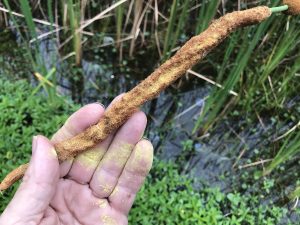
Cattail blossom producing pollen. Photo by Green Deane
Two other species that are “blossoming” now are familiar ones, Pines and Cattails. Males pine cones, yes there are such a thing, are dropping pollen now. Called microsporangiate strobili, they are edible but don’t have much of a flavor or pleasing texture. Their pollen, however, is edible and can have some hormonal uses as well. Interestingly pine pollen is often blamed for Hay Fever but usually it’s Ragweed that is causing allergy problems at about the same time. Pine pollen is heavy and doesn’t travel far whereas Ragweed pollen is light and floats long distances. You can read about pines here, video here. Also producing pollen powder now are Cattails. Far more productive than male pine cones, the male part of the Cattail blossom produces a dense, yellow, pollen. It’s relatively easy to collect and quite useful such as augmenting bread flour. The dry female part of the blossom — the cat tail part — is edible but is as unattractive to eat as the male pine cone. You can read more about the Cattail here, video here.
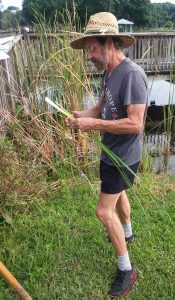
Teaching a foraging class in West Palm Beach
Foraging Classes: The weather gods may smile upon us this weekend with clear days this weekend for a class near Orlando and one in Sarasota.
Saturday, February 8th, Mead Garden: 1500 S. Denning Dr., Winter Park, FL 32789. Meet at the parking lot. 9 a.m. to noon.
Sunday, February 9th, Red Bug Slough Preserve, 5200 Beneva Road, Sarasota, FL, 34233. 9 a.m. to noon.
Saturday, February 15th, Boulware Springs Park, 3420 SE 15th St., Gainesville, FL 32641. Meet at the picnic tables next to the pump house. 9 a.m. to noon.
Sunday, February 2nd, Eagle Park Lake, 1800 Keene Road, Largo, FL 33771. Meet at the pavilion near the dog park. 9 a.m to noon. (This is to make up for an earlier class here that has scheduling issues.)
Saturday, March 7th, Blanchard Park, 10501 Jay Blanchard Trail, Orlando, FL 32817. 9 a.m. to noon. Meet at the pavilion near the YMCA building and tennis courts.
Sunday, March 8th, George LeStrange Preserve, 4911 Ralls Road, Fort Pierce, FL, 34981. 9 a.m. to noon. (There are no official bathrooms at this location.)
Saturday, March 28th, Haulover Canal, Merritt Island National Refuge, north of the Kennedy Space Center. 9 a.m. to noon. Read the instructions below. We meet the the northwest end of the canal area.
Sunday, March 29th, Spruce Creek Park, 6250 Ridgewood Ave. Port Orange FL, meet at the pavilion. 9 a.m. to noon.
For more information, to sign up for a class, or to pre page, go here.
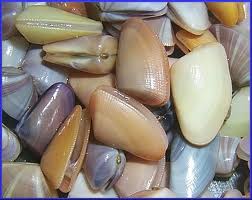
Coquina are tasty but quite small.
Sometime instead finding answers they find you. As you know there are several articles on the EatTheWeeds website that are about edibles covered by the subtitle: And other things, too. That subtitle was intentionally added when the site went up some 14 years ago. There are a lot of things in the world to eat. Before Andrew Zimmern was traipsing around the globe for the Travel Channel eating untraditional food EatTheWeeds was writing about them. As one might expect that has caused a good amount of disagreeing mail. Many people keep as pets creatures that other people eat. Thus far, however, no one has complained about Coquina, a coastal clam that’s about the size of your fingernail. The tiny clams make an absolutely delicious green broth that I like to add — I know it’s sacrilege — instant potatoes and butter to. One of the down sides is that the clams are so small getting the meat out of the shell is microscopic work. That is so frustrating as most of it is tossed away. However in Australia they figured out a commercial way of separating meat and shell. How that was done was something of a mystery until a post on the Green Deane Forum provided an answer. The cooked shells are vigorously stired. After that it is a matter of straining the shells from the meat. I’ve got to try that. You can read about Coquina here, and the crunchy Mole Crabs, here. A video on both of them is here.
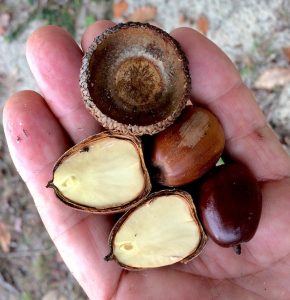
Chestnut Oak acorns are the largest we have locally. Photo by Green Deane
Many people are surprised to learn most acorns are edible if processed. They were a staple for many native groups who had a wide variety of ways to make them palatable. The amount of acorns a tree produces — called a mast — is effected by weather specifically temperatures, rain and wind. Setting aside temperatures and wind for a moment the amount of spring rain affects the mast. Usually a wet spring means more acorns. But you also need some dry days at the right time to wind-carry the pollen around. Winds distribute that pollen for miles. Bees do visit oaks blossoms but they are considered a minor pollinator. Throwing a kink in this are temperatures. There are about a dozen different species of oaks locally and they usually don’t all pollinate at the some time unless the weather has been cold. That forestalls some species from pollinating creating more species pollinating at the same time. They wait for warmer weather and that translate into higher amounts of pollen than usual. This is very bad news locally for those who are allergic to oak pollen. You can read about acorns here. A video on acorns is here.
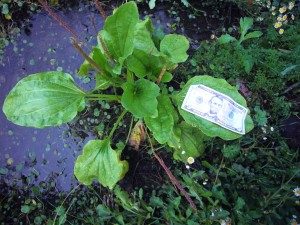
Plantago rugelii is a large local plantago. Photo by Green Deane
Plantago Power: It was a dark and rainy … morning… and I was searching through the gloom along the road for a wild mustard/radish for my foraging class. It was cold. It was rainy. It was gray. Something caught my eye so I pulled Van Go over and headed towards a watery ditch. Then I heard a baby cry. Seriously. The figure I thought was a bag lady with stuffed shopping cart was a bundled-up woman with a baby stroller waiting for a bus. Things look different in the dim drab of winter. And the plant I thought might be a mustard most certainly was not. It was a Plantago, the largest one I have ever seen. That was worth a picture and posting on the Green Deane Forum. There one of our regular members, Josey, who has an eye for detail and a whole lot of knowledge, offered it as Plantago Rugelii rather than P. major. One difference is the P. rugelii has purple at the base of the petiole, P. major is white. Unlike P.major, which is from Europe, P. rugelii is native to North America. It is odd that we don’t hear more about it. You can read about it here and watch a video here.

Foraging DVDs make a good gift to watch during the lifeless months of winter.
Though your foraging may drop off during the winter it’s a great time to study wild edibles with my nine DVD set. Each DVDs has 15 videos for 135 in all. They make a great gift. Order today. Some of these videos are of better quality than my free ones on the Internet. They are the same videos but many people like to have their own copy. I burn and compile the sets myself so if you have any issues I handle them personally. There are no middle foragers. And I’m working on adding a tenth DVD. To learn more about the DVDs or to order them click here.

Green Deane Forum
Want to identify a plant? Perhaps you’re looking for a foraging reference? You might have a UFO, an Unidentified Flowering Object, you want identified. On the Green Deane Forum we — including Green Deane and others from around the world — chat about foraging all year. And it’s not just about warm-weather plants or just North American flora. Many nations share common weeds so there’s a lot to talk. There’s also more than weeds. The reference section has information for foraging around the world. There are also articles on food preservation, and forgotten skills from making bows to fermenting food.
This is weekly newsletter 391, If you want to subscribe to this free newsletter you can find the sign-up form in the menu at the top of the page.
To donate to the Green Deane Newsletter click here.


Hi Green, 3Pts; I made Coquina soup 50 yrs ago after a spring break trip to Crescent Beach. I raved about the delicious golden broth. I returned 25 yr ago and collected a few gallons via deft use of a collander; delish. 18 yrs ago I returned, collected and was disappointed as the soup had a strong “plastic odor” and was sent to a marine lab that found no contaminants..Just beware, sniff, decide..may have been a onetime thing…..Acorn mast has failed twice in the last five years here in Suwannee Cty or been very spotty disrupting usual patterns of deer/turkey/duck and was observed by many hunter friends..The ice storm 3 yrs ago actually killed a huge live oak in full bloom at the time. AS winters have been punctuated with unusually warm weeks of late, odd and early blooms are noted in many species like my blood orange in full bloom since Christmas?…..Following your mention of Oyster mushrooms a few weeks ago I found a bounty on a downed water oak, never before seen on my farm…..added to my repertoire of honey ringless and lion mane thanks to you….Sir, you are a public treasure! Best, Randall
My grandmother used to pickle redbud blossoms. I don’t remember them having much flavor, but they were so pretty.
Sincerely, l hope ,with all the enormous knowledge , lot of experience and wiisdom above all , you contribute in writing even shortly about Corona – thanks .